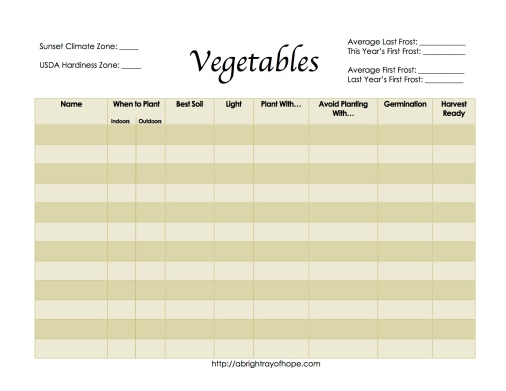On Friday, Aaron said to me, “We should start planning what we want to plant this year.” And I said, “Oh, right, I meant to make something for that!” Because, as I so often do, I had had a brilliant idea for garden planning, but then I’d forgotten my brilliant idea. (Have I mentioned that a common characteristic of people with ADHD is forgetfulness?) Aaron’s comment jogged my memory just in time.
My brilliant plan had originally been to create a spreadsheet that listed the plants we already have, plus those we want to plant, with their key data: when to plant, what type of soil, best light, when to expect blossoms or fruit. I even thought of adding more details for flowers: average plant height, flower color, foliage color, and so on, for visual planning. In a spreadsheet, I thought, I could then easily organize by, for example, planting time, and voila! My spreadsheet would become a planting calendar. Or I could choose to order it by soil type to help me decide where to plant, and so on.
As I so often do when considering my brilliant ideas, I quickly realized that this one might be a tiny bit beyond my reach, at least this year, because a) I’m not really that great at creating spreadsheets, and b) this would be incredibly time-consuming. However, several years of teaching has made me REALLY great at designing charts and worksheets, and it occurred to me that if I made a printable chart with space for the same data, I could use it as a planning worksheet right now, and save the filled-in sheet for later…just in case I someday want to create a more complex data entry system for keeping track of plants in our garden.
I ended up making three sheets: one each for flowers, herbs, and vegetables. I may later make one for fruit too, but since we’re not planning on putting in any new fruit this year, that can wait. Each sheet starts with a place to jot down the following climate data: Sunset Climate Zone; USDA Hardiness Zones (I found that link and information at The National Gardening Association); and the average time of the first and last frosts as well as last year’s first frost and this year’s last frost (you can find this information at Old Farmer’s Almanac and Dave’s Garden, among other places). I included a spot for both the Sunset Climate Zone and the USDA Hardiness Zone because they both provide advantages when planning what to plant. The USDA Hardiness Zone is used most often on plant labels and seed packages, but it’s not nearly as useful in Western North America as it is in the East. That’s because it only accounts for average winter temperature, not for rainfall or snow. In the western half of the continent, both of those factors heavily impact what types of plants grow best, and both are highly variable over here even when winter temperature averages are similar. The Sunset Climate Zone system does take this into account… but since most plant distributors use USDA data, you have to do a bit more work to discover what plants grow best in each Sunset zone.
Then I added a table with the following headings: When to Plant, Best Soil, Light, Plant With…, Avoid Planting With…, Germination, and Bloom (or Harvest) Time. I’m pretty happy with the way it turned out. I’m leaving it out on the desk so I can quickly jot down plants that I think of, and later I can research to find information about planting, which I can then record as I have time. This is making me so excited! I can hardly wait to get started with planting!
If you click on the title above each chart image, you should get a PDF that opens in a new screen. That way, you can print these charts for your own use. Happy gardening!




I love your spreadsheets! I really enjoy planning out my garden. I usually draw out my plans on a piece of paper, notating what will go where inside the garden and that goes all well and good until I realize that I have to share my garden with another person! This year, I have access to two gardens to grow in that I’m excited about.
LikeLike
Sharing makes it tricky! My husband pretty much leaves the planting decisions up to me so far. He takes care of pruning, mowing, leaf blowing, etc., and lets me do the more finicky stuff.
LikeLike